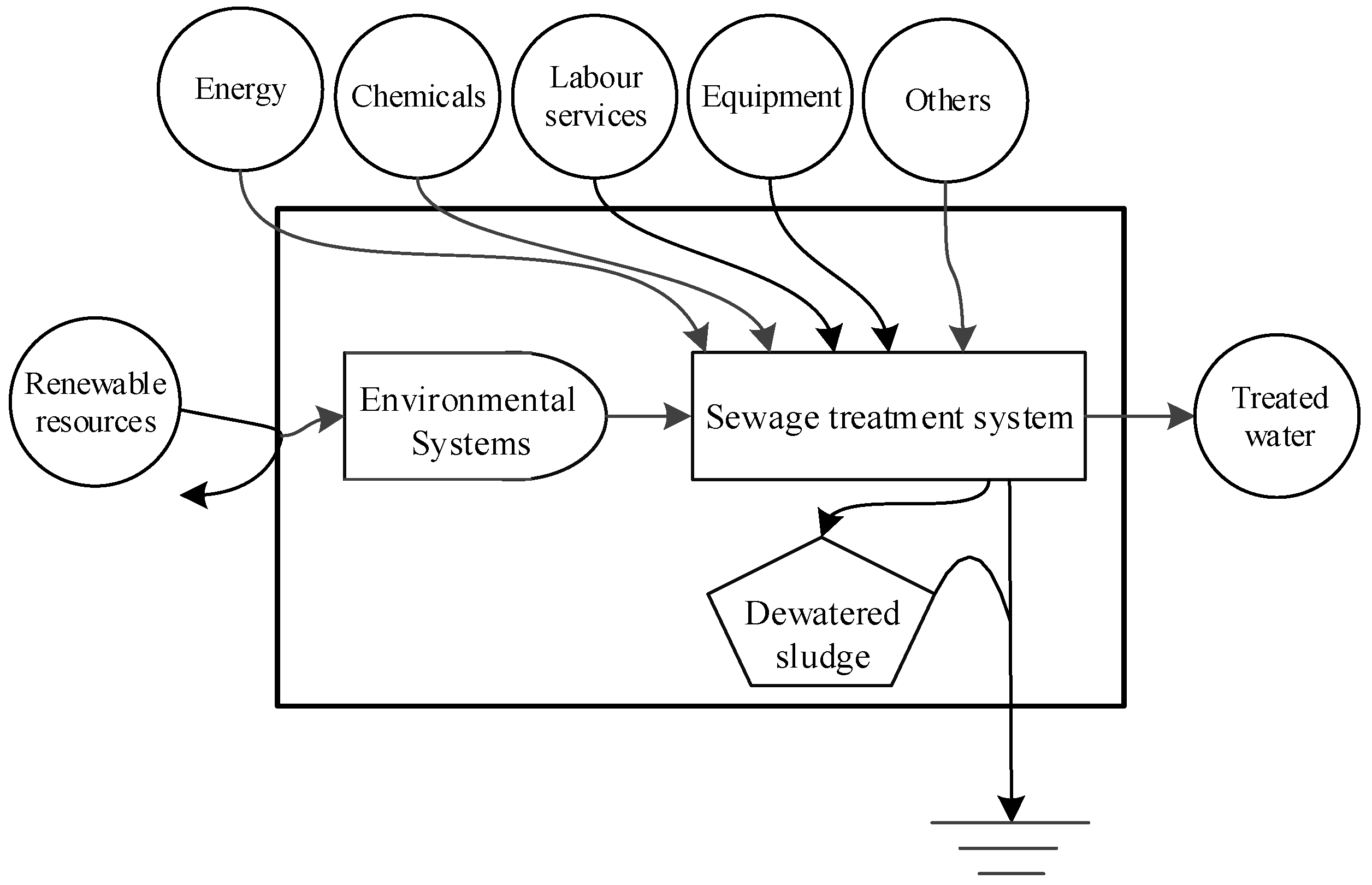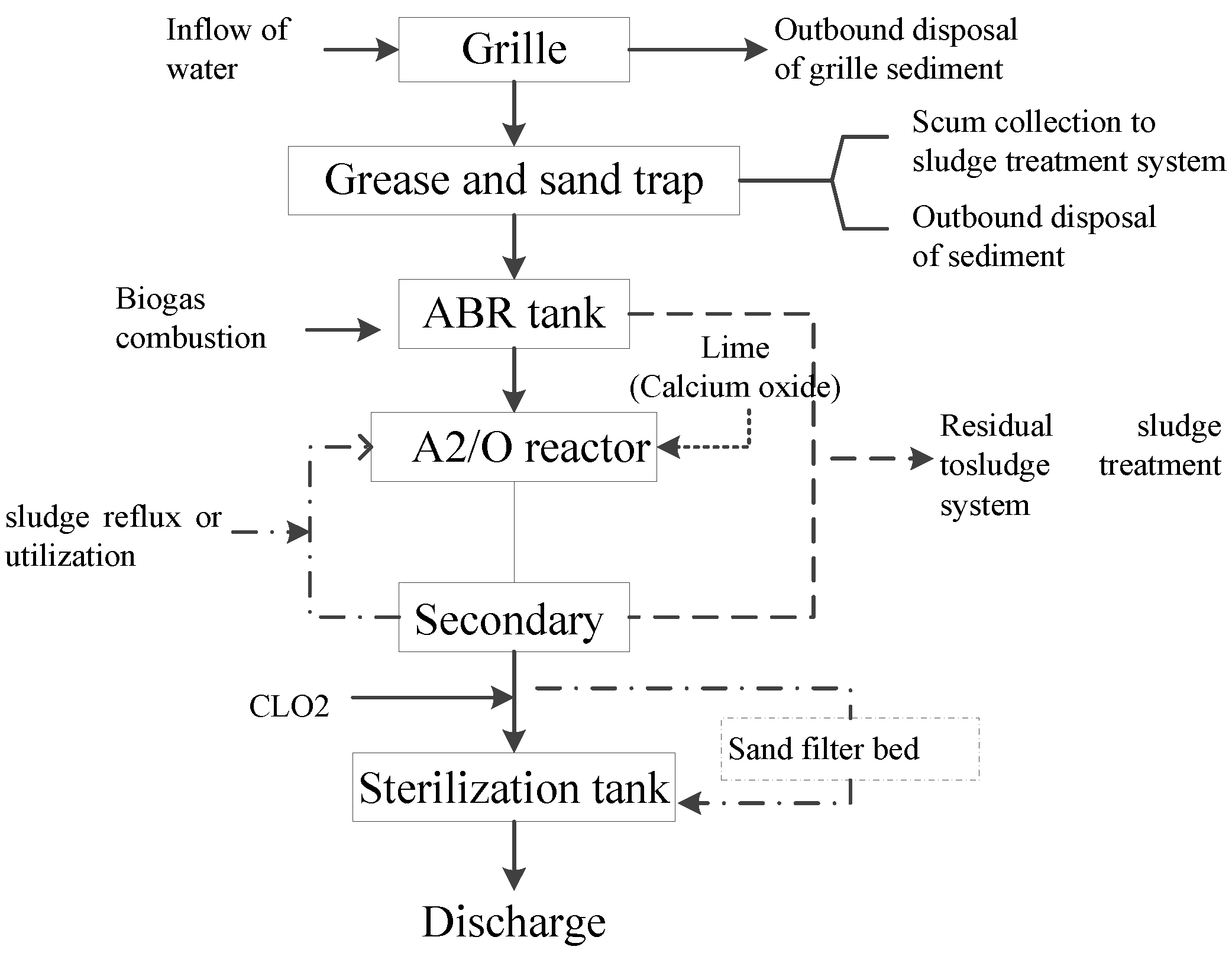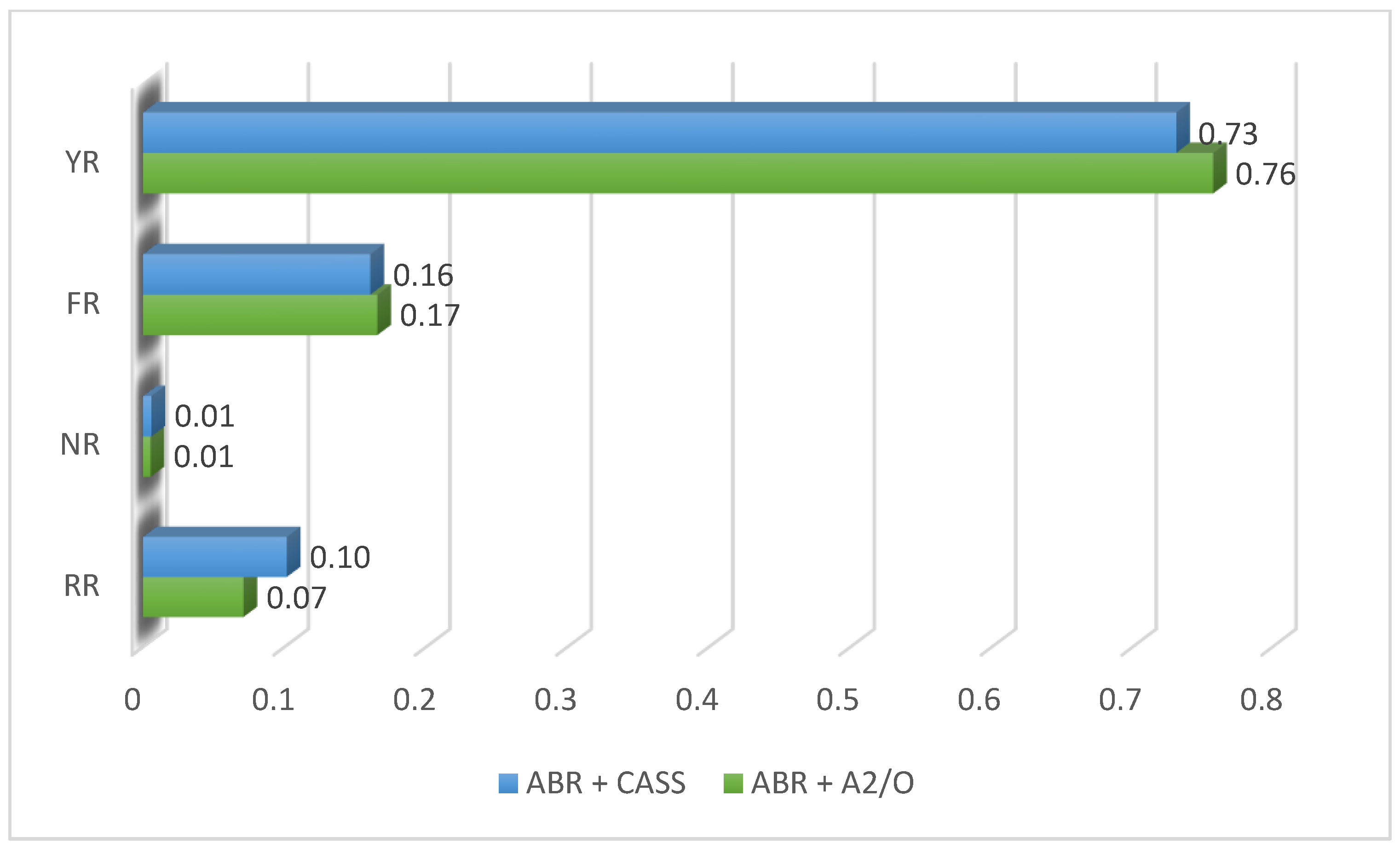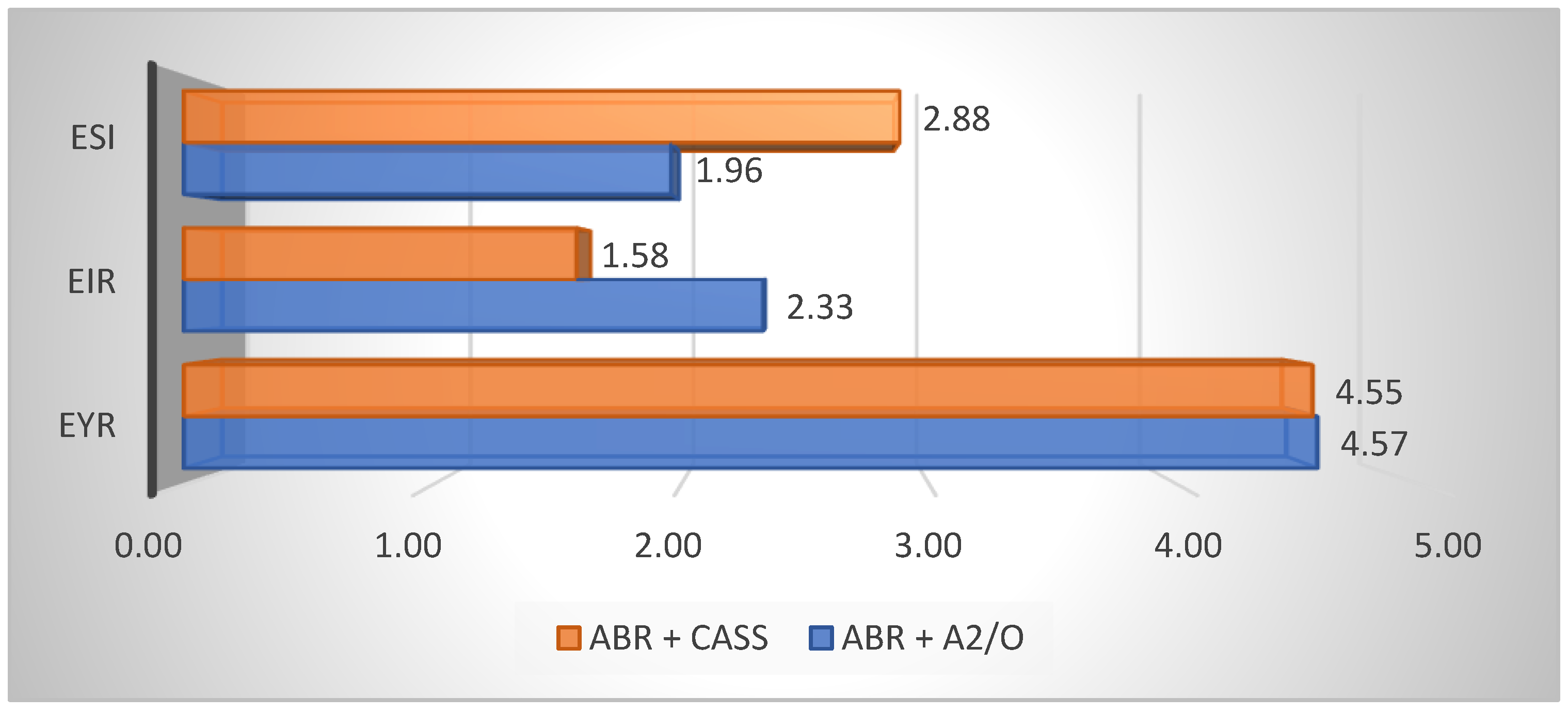Study on the Choice of Wastewater Treatment Process Based on the Emergy Theory
Abstract
:1. Introduction
2. Materials and Methods
2.1. Emergy Analysis Method
2.2. Selection of Indicators
- (1)
- EYR (Emergy Yield Ratio): Ratio of the amount of emergy produced by a wastewater treatment system to the amount of emergy purchased from society. The core value of a wastewater treatment system is to prevent ecological and human health damage caused by the direct discharge of wastewater; therefore, its yield includes reclaimed water and dewatered sludge. It is calculated as follows:where EMY is the yield emergy of the wastewater treatment system and EMF is the economic feedback input resource emergy, i.e., the purchase emergy. A larger EYR value means a higher emergy yield under a certain emergy input. The higher the production efficiency, the higher the corresponding economic benefits, reflecting that the system has higher market competitiveness.EYR = EMY/EMF
- (2)
- ELR (Environmental Load Rate): Sum of non-renewable resource emergy and purchased emergy divided by the renewable resource emergy, expressed as follows:where EMN is the non-renewable resource emergy and EMR is the renewable resource emergy. The main purpose of a wastewater treatment system is to eliminate or relieve environmental stress. ELR represents the magnitude of the stress caused by the treatment process on the environment [35], and a higher value means that the operational process of the wastewater treatment system is causing more stress to the environment. To avoid too great an impact of the wastewater treatment process on the environment and irreversible degradation or loss of function, the system cannot be subjected to a high ELR for a long period.ELR = (EMN + EMF)/EMR
- (3)
- ESI (Emergy Sustainability development Index): Sustainable development requires a high level of beneficial output for a given resource input, while maintaining a low level of environmental stress; therefore, the ESI is the ratio of the EYR to the ELR, expressed as follows:ESI = EYR/ELRESI is used to measure the sustainability of an activity [36]. A higher ESI means that the system is more effective and shows better sustainability under certain conditions.
3. Case Study
3.1. Background
3.2. Principles and Advantages of the Two Wastewater Treatment Processes
3.2.1. ABR + A2/O Process
- (a)
- The anaerobic component of the ABR tank involves a simple, low-investment process that does not require expensive influent systems and complexly designed three-phase separators, nor mechanical mixing devices and additional clarification and sedimentation tanks of conventional anaerobic digesters.
- (b)
- Good biodistribution and biosolid retention capacity with good hydraulic mixing conditions.
- (c)
- No sludge bulking.
- (d)
- A2/O tank with micro-perforated aeration pipe and high oxygen utilization.
- (e)
- The process is mature and reliable, and the treatment effect is stable.
3.2.2. ABR + CASS Process
- (a)
- Aerobic tank part does not require a secondary sedimentation tank or regulating and primary sedimentation tanks, has no secondary sedimentation tank or sludge reflux equipment, has a compact layout of wastewater treatment facilities, and has a relatively small overall area and low investment.
- (b)
- Designed with flow variation in mind, it is flexible in operation and shock resistant, achieving different treatment goals.
- (c)
- The biochemical reaction has a high driving force, good sedimentation effect, a small amount of residual sludge, and a stable nature.
3.3. Results
4. Discussion
5. Conclusions
- (1)
- As an important part of urban infrastructure and a critical link in water pollution control, wastewater treatment is a socially beneficial project, which has significance for developing the national economy and environmental protection and resource reuse. Therefore, when selecting an appropriate wastewater treatment process, its economic benefits and influence on the environment from a sustainable development perspective should be considered.
- (2)
- The emergy method, when used for wastewater treatment process selection, uses a unified standard for measuring various resources and materials for inputs and outputs and can provide a reference for wastewater treatment plants to select a suitable treatment process for themselves by comparing the indicators.
- (3)
- The results indicate that the ABR + A2/O process had higher economic efficiency with the same wastewater treatment capacity; however, the ABR + CASS process was less damaging to the environment, had lower economic input and better sustainability and ecological economy, and more favorable economic policies can make it more widely promoted.
Author Contributions
Funding
Data Availability Statement
Conflicts of Interest
References
- United Nations Educational, Scientific and Cultural Organization (UNESCO). The United Nations World Water Development Report 2018: Nature-Based Solutions for Water; UNESCO: Paris, France, 2018; Volume 3. [Google Scholar]
- Cai, W.; Lai, K.H.; Liu, C.; Wei, F.; Ma, M.; Jia, S.; Jiang, Z.G.; Lv, L. Promoting sustainability of manufacturing industry through the lean energy-saving and emission-reduction strategy. Sci. Total Environ. 2019, 665, 23–32. [Google Scholar] [CrossRef] [PubMed]
- Liu, C.H.; Gao, M.D.; Zhu, G.; Zhang, C.X.; Zhang, P.; Chen, J.Q.; Cai, W. Data driven eco-efficiency evaluation and optimization in industrial production. Energy 2021, 224, 120170. [Google Scholar] [CrossRef]
- Ji, M.; Liu, Z.; Sun, K.; Li, Z.; Fan, X.; Li, Q. Bacteriophages in water pollution control: Advantages and limitations. Front. Environ. Sci. Eng. 2021, 15, 84. [Google Scholar] [CrossRef] [PubMed]
- Rice, J.; Westerhoff, P. High levels of endocrine pollutants in US streams during low flow due to insufficient wastewater dilution. Nat. Geosci. 2017, 10, 587–591. [Google Scholar] [CrossRef]
- Dong, X.; Zhang, X.; Zeng, S. Measuring and explaining eco-efficiencies of wastewater treatment plants in China: An uncertainty analysis perspective. Water Res. 2017, 112, 195–207. [Google Scholar] [CrossRef]
- Wang, Q.; Wu, Y.Y.; Wen, Y.L. Research on the status and problem of wastewater treatment facilities construction in China. Environ. Pollut. Control 2015, 37, 94–101. [Google Scholar]
- Åmand, L.; Carlsson, B. Optimal aeration control in a nitrifying activated sludge process. Water Res. 2012, 46, 2101–2110. [Google Scholar] [CrossRef]
- Kazora, A.S.; Mourad, K.A. Assessing the sustainability of decentralized wastewater treatment systems in Rwanda. Sustainability 2018, 10, 4617. [Google Scholar] [CrossRef] [Green Version]
- Vashi, A.N.; Shah, N.C. Impacts of a participatory approach to assess sustainable sewage treatment technologies for urban fringe of Surat city in India. Water. Sci. Technol. 2008, 57, 1957–1962. [Google Scholar] [CrossRef]
- Gronlund, S.E. Indicators and methods to assess sustainability of wastewater sludge management in the perspective of two systems ecology models. Ecol. Indic. 2019, 100, 45–54. [Google Scholar] [CrossRef]
- Shao, L.; Chen, G.Q. Exergy based renewability assessment: Case study to ecological wastewater treatment. Ecol. Indic. 2015, 58, 392–401. [Google Scholar] [CrossRef]
- An, D.; Xi, B.D.; Ren, J.Z.; Ren, X.S.; Zhang, W.S.; Wang, Y.; Dong, L.C. Multi-criteria sustainability assessment of urban sludge treatment technologies: Method and case study. Resour. Convers. Recyl. 2018, 128, 546–554. [Google Scholar] [CrossRef]
- Jang, J.; Park, S.; Park, J.; Kim, H.; Kim, J.; Lee, H. Energy assessment and savings for the sewage treatment plant using EUAT and tool-kit in Korea. Desalin. Water Treat. 2019, 154, 132–140. [Google Scholar] [CrossRef]
- Molinos-Senante, M.; Gemar, G.; Gomez, T.; Caballero, R.; Sala-Garrido, R. Eco-efficiency assessment of wastewater treatment plants using a weighted Russell directional distance model. J. Clean. Prod. 2016, 137, 1066–1075. [Google Scholar] [CrossRef]
- Mayer, F.; Bhandari, R.; Gath, S.A. Life cycle assessment of prospective sewage sludge treatment paths in Germany. J. Environ. Manag. 2021, 290, 112557. [Google Scholar] [CrossRef]
- Gallego-Schmid, A.; Tarpani, R.R.Z. Life cycle assessment of wastewater treatment in developing countries: A review. Water Res. 2019, 53, 63–79. [Google Scholar] [CrossRef] [PubMed] [Green Version]
- Teoh, S.K.; Li, L.Y. Feasibility of alternative sewage sludge treatment methods from a lifecycle assessment (LCA) perspective. J. Clean. Prod. 2020, 247, 119495. [Google Scholar] [CrossRef]
- Liu, W.X.; Iordan, C.M.; Cherubini, F.; Hu, X.P.; Fu, D.F. Environmental impacts assessment of wastewater treatment and sludge disposal systems under two environmental impacts assessment of wastewater treatment and sludge disposal systems under two sewage discharge standards: A case study in Kunshan, China. J. Clean. Prod. 2021, 287, 125046. [Google Scholar] [CrossRef]
- Odum, H.T. Self-organization, transformity, and information. Science 1988, 242, 1132–1139. [Google Scholar] [CrossRef] [Green Version]
- Amiri, Z.; Asgharipour, M.R.; Campbell, D.E. Conservation agriculture, a selective model based on emergy analysis for sustainable production of shallot as a medicinal-industrial plant. J. Clean Prod. 2021, 292, 126000. [Google Scholar] [CrossRef]
- Artuzo, F.D.; Allegretti, G.; Santos, O.I.B.; da Silva, L.X.; Talamini, E. Emergy unsustainability index for agricultural systems assessment: A proposal based on the laws of thermodynamics. Sci. Total Environ. 2021, 759, 143524. [Google Scholar] [CrossRef]
- Liu, C.H.; Cai, W.; Dinolov, O.; Zhang, C.X.; Rao, W.Z.; Jia, S.; Li, L.; Chan, F.T.S. Emergy based sustainability evaluation of re-manufacturing machining systems. Energy 2018, 150, 670–680. [Google Scholar] [CrossRef]
- Wang, C.; Liu, H.J.; Yu, L.E.; Wang, H.Y. Study on the sustainability evaluation method of logistics parks based on emergy. Processes 2020, 8, 1247. [Google Scholar] [CrossRef]
- Cai, W.; Liu, C.H.; Zhang, C.X.; Ma, M.D.; Rao, W.Z.; Li, W.Y.; He, K.; Gao, M.D. Developing the ecological compensation criterion of industrial solid waste based on emergy for sustainable development. Energy 2018, 157, 940–948. [Google Scholar] [CrossRef]
- Wang, C.; Zhang, Y.; Liu, C.; Hu, F.; Zhou, S.; Zhu, J. Emergy-based assessment and suggestions for sustainable development of regional ecological eonomy: A case study of Anhui Province, China. Sustainability 2021, 13, 2988. [Google Scholar] [CrossRef]
- Sun, L.; Li, H.; Dong, L.; Fang, K.; Ren, J.Z.; Geng, Y.; Fujii, M.; Zhang, W.; Zhang, N.; Liu, Z. Eco-benefits assessment on urban industrial symbiosis based on material flows analysis and emergy evaluation approach: A case of Liuzhou city, China. Resour. Convers. Recycl. 2017, 119, 78–88. [Google Scholar] [CrossRef] [Green Version]
- Liu, C.H.; Cai, W.; Zhai, M.Y.; Zhu, G.; Zhang, C.X.; Jiang, Z.G. Decoupling of wastewater eco-environmental damage and China’s economic development. Sci. Total Environ. 2021, 789, 147980. [Google Scholar] [CrossRef]
- Zhang, J.X.; Ma, L. Environmental sustainability assessment of a new sewage treatment plant in China based on infrastructure construction and operation phases emergy analysis. Water 2020, 12, 484. [Google Scholar] [CrossRef] [Green Version]
- Alizadeh, S.; Zafari-koloukhi, H.; Rostami, F.; Rouhbakhsh, M.; Avami, A. The eco-efficiency assessment of wastewater treatment plants in the city of Mashhad using emergy and life cycle analyses. J. Clean. Prod. 2020, 249, 119327. [Google Scholar] [CrossRef]
- Zhang, J.X.; Ma, L.; Yan, Y.Y. A dynamic comparison sustainability study of standard wastewater treatment system in the straw pulp papermaking process and printing & dyeing papermaking process based on the hybrid neural network and emergy framework. Water 2020, 12, 1781. [Google Scholar]
- Londono, N.A.; Suarez, D.G.; Velasquez, H.I.; Ruiz-Mercado, G.J. Emergy analysis for the sustainable utilization of biosolids generated in a municipal wastewater treatment plant. J. Clean. Prod. 2017, 141, 182–193. [Google Scholar] [CrossRef]
- Shao, S.; Mu, H.; Yang, F.; Zhang, Y.; Li, J. Application of emergy analysis to the sustainability evaluation of municipal wastewater treatment plants. Sustainability 2017, 9, 8. [Google Scholar] [CrossRef] [Green Version]
- Gronlund, E.; Billgren, C.; Tonderski, K.S.; Raburu, P.O. Emergy assessment of a wastewater treatment pond system in the Lake Victoria Basin. J. Environ. Account. Manag. 2017, 5, 11–26. [Google Scholar] [CrossRef]
- Brown, M.T.; Ulgiati, S. Emergy analysis and environmental accounting. Encycl. Energy 2004, 2, 329–354. [Google Scholar]
- Brown, M.T.; Ulgiati, S. Emergy-based indices and rations to evaluate sustainability: Monitoring economics and technology toward environmentally sound innovation. Ecol. Eng. 1997, 5, 51–69. [Google Scholar] [CrossRef]
- Odum, H.T. Handbook of Emergy Evaluation: Folio #2 Emergy of Global Processes; Center for Environmental Policy, Environmental Engineering Sciences, University of Florida: Gainesville, FL, USA, 2000. [Google Scholar]
- Li, J.R.; Zhang, X.H.; Zhang, H.B.; Pan, H.Y.; Liu, Q. Assessing the environmental and economical benefits of integrated sewage treatment systems. J. Appl. Ecol. 2015, 26, 2482–2492. [Google Scholar]
- Geng, Z.Q.; Song, G.L.; Han, Y.M.; Chu, C. Static and dynamic energy structure analysis in the world for resource optimization using total factor productivity method based on slacks-based measure integrating data envelopment analysis. Energy Convers. Manag. 2021, 228, 113713. [Google Scholar] [CrossRef]





| Item | Basic Data | Emergy Conversion Rate | Solar Energy | Reference |
|---|---|---|---|---|
| Solar energy (J) | 3.99 × 1013 | 1 | 3.99 × 1013 | [20] |
| Wind energy (J) | 1.25 × 1010 | 6.63 × 102 | 8.29 × 1012 | [20] |
| Rainwater chemical energy (J) | 5.13 × 1010 | 1.54 × 104 | 7.90 × 1014 | [20] |
| Geothermal energy (J) | 2.15 × 1010 | 2.90 × 104 | 6.24 × 1014 | [20] |
| Hydroelectricity (J) | 2.79 × 1012 | 1.29 × 105 | 3.60 × 1017 | [37] |
| Labor service (CNY) | 9.46 × 105 | 8.61 × 1011 | 8.15 × 1017 | [28] |
| ClO2 (g) | 2.89 × 105 | 6.46 × 1010 | 1.87 × 1016 | Investigation |
| Polymeric aluminum chloride (g) | 2.33 × 106 | 1.64 × 109 | 3.81 × 1015 | Investigation |
| Phosphide remover (g) | 3.51 × 106 | 8.61 × 108 | 3.02 × 1015 | Investigation |
| Flocculant (g) | 1.57 × 106 | 1.21 × 109 | 1.89 × 1015 | Investigation |
| Treatment water (g) | 5.96 × 1012 | 6.46 × 105 | 3.85 × 1018 | [38] |
| Item | Basic Data | Energy Conversion Rate | Solar Energy | Reference |
|---|---|---|---|---|
| Solar energy (J) | 3.99 × 1013 | 1 | 3.99 × 1013 | [20] |
| Wind energy (J) | 1.25 × 1010 | 6.63 × 102 | 8.29 × 1012 | [20] |
| Rainwater chemical energy (J) | 5.13 × 1010 | 1.54 × 104 | 7.90 × 1014 | [20] |
| Geothermal energy (J) | 2.15 × 1010 | 2.90 × 104 | 6.24 × 1014 | [20] |
| Hydroelectricity (J) | 4.14 × 1012 | 1.29 × 105 | 5.34 × 1017 | [37] |
| Labor service (CNY) | 9.46 × 105 | 8.61 × 1011 | 8.15 × 1017 | [28] |
| ClO2 (g) | 3.00 × 105 | 6.46 × 1010 | 1.94 × 1016 | Investigation |
| Polymeric aluminum chloride (g) | 4.39 × 106 | 1.64 × 109 | 7.19 × 1015 | Investigation |
| Phosphide remover (g) | 5.57 × 106 | 8.61 × 108 | 4.80 × 1015 | Investigation |
| Flocculant (g) | 4.27 × 105 | 1.21 × 109 | 5.15 × 1014 | Investigation |
| Treatment water (g) | 5.96 × 1012 | 6.46 × 105 | 3.85 × 1018 | [38] |
| Energy Indicators | ABR + A2/O | ABR + CASS |
|---|---|---|
| Energy flow | ||
| Renewable resource capacity values | 3.61 × 1017 | 5.36 × 1017 |
| Non-renewable resource capacity values | 2.74 × 1016 | 3.19 × 1016 |
| Purchase of energy | 8.42 × 1017 | 8.46 × 1017 |
| Yield value | 3.85 × 1018 | 3.85 × 1018 |
| Evaluation indicators | ||
| Energy yield ratio | 4.57 | 4.55 |
| Environmental load factor | 2.33 | 1.58 |
| Indicators of sustainable development in terms of energy | 1.96 | 2.88 |
Publisher’s Note: MDPI stays neutral with regard to jurisdictional claims in published maps and institutional affiliations. |
© 2021 by the authors. Licensee MDPI, Basel, Switzerland. This article is an open access article distributed under the terms and conditions of the Creative Commons Attribution (CC BY) license (https://creativecommons.org/licenses/by/4.0/).
Share and Cite
Wang, C.; Liu, C.; Si, X.; Zhang, C.; Liu, F.; Yu, L.; Chen, G. Study on the Choice of Wastewater Treatment Process Based on the Emergy Theory. Processes 2021, 9, 1648. https://doi.org/10.3390/pr9091648
Wang C, Liu C, Si X, Zhang C, Liu F, Yu L, Chen G. Study on the Choice of Wastewater Treatment Process Based on the Emergy Theory. Processes. 2021; 9(9):1648. https://doi.org/10.3390/pr9091648
Chicago/Turabian StyleWang, Cui, Changyi Liu, Xiaoxiao Si, Cuixia Zhang, Fan Liu, Li’e Yu, and Guohua Chen. 2021. "Study on the Choice of Wastewater Treatment Process Based on the Emergy Theory" Processes 9, no. 9: 1648. https://doi.org/10.3390/pr9091648
APA StyleWang, C., Liu, C., Si, X., Zhang, C., Liu, F., Yu, L., & Chen, G. (2021). Study on the Choice of Wastewater Treatment Process Based on the Emergy Theory. Processes, 9(9), 1648. https://doi.org/10.3390/pr9091648







